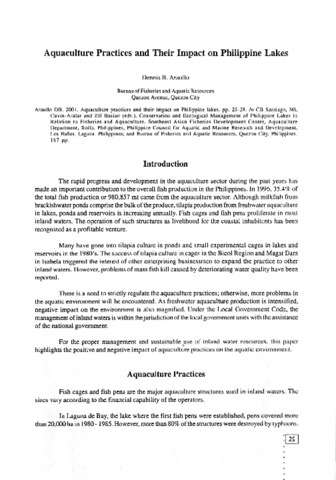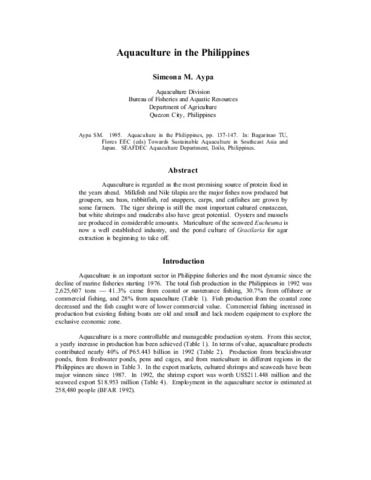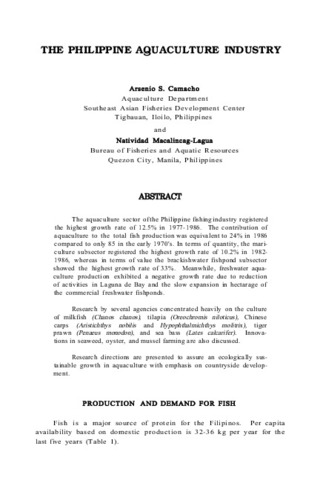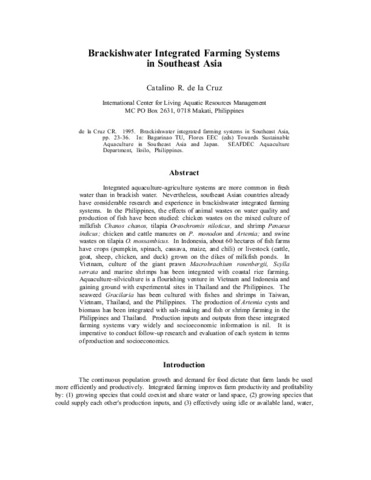Aquaculture practices and their impact on Philippine Lakes
Share
abstrak
The rapid progress and development in the aquaculture sector during the past years has made an important contribution to the overall fish production in the Philippines. In 1996, 35.4% of the total fish production or 980,857 mt came from the aquaculture sector. Although milkfish from brackishwater ponds comprise the bulk of the produce, tilapia production from freshwater aquaculture in lakes, ponds and reservoirs is increasing annually. Fish cages and fish pens proliferate in most inland waters. The operation of such structures as livelihood for the coastal inhabitants has been recognized as a profitable venture.
Many have gone into tilapia culture in ponds and small experimental cages in lakes and reservoirs in the 1980's. The success of tilapia culture in cages in the Bicol Region and Magat Dam in Isabela triggered the interest of other enterprising businessmen to expand the practice to other inland waters. However, problems of mass fish kill caused by deteriorating water quality have been reported.
There is a need to strictly regulate the aquaculture practices; otherwise, more problems in the aquatic environment will be encountered. As freshwater aquaculture production is intensified, negative impact on the environment is also magnified. Under the Local Government Code, the management of inland waters is within the jurisdiction of the local government units with the assistance of the national government.
For the proper management and sustainable use of inland water resources, this paper highlights the positive and negative impact of aquaculture practices on the aquatic environment.
Suggested Citation
Araullo, D. B. (2001). Aquaculture practices and their impact on Philippine lakes. In C. B. Santiago, M. L. Cuvin-Aralar, & Z. U. Basiao (Eds.), Conservation and Ecological Management of Philippine Lakes in Relation to Fisheries and Aquaculture (pp. 25-28). Tigbauan, Iloilo, Philippines: Aquaculture Department, Southeast Asian Fisheries Development Center; Los Baños, Laguna, Philippines: Philippine Council for Aquatic and Marine Research and Development (PCAMRD), Department of Science and Technology; Quezon City, Philippines: Bureau of Fisheries and Aquatic Resources (BFAR), Department of Agriculture, Quezon City, Philippines.
Subjek
Taxonomic term
Related items
Showing items related by title, author, creator and subject.
-
Aquaculture in the Philippines
Aypa, Simeona M. (Aquaculture Department, Southeast Asian Fisheries Development Center, 1995)Aquaculture is regarded as the most promising source of protein food in the years ahead. Milkfish and Nile tilapia are the major fishes now produced but groupers, sea bass, rabbitfish, red snappers, carps, and catfishes ... -
The Philippine aquaculture industry
Camacho, Arsenio S.; Macalincag-Lagua, Natividad (Aquaculture Department, Southeast Asian Fisheries Development Center, 1988)The aquaculture sector of the Philippine fishing industry registered the highest growth rate of 12.5% in 1977-1986. The contribution of aquaculture to the total fish production was equivalent to 24% in 1986 compared to ... -
Brackishwater integrated farming systems in Southeast Asia
De la Cruz, Catalino R. (Aquaculture Department, Southeast Asian Fisheries Development Center, 1995)Integrated aquaculture-agriculture systems are more common in fresh water than in brackish water. Nevertheless, southeast Asian countries already have considerable research and experience in brackishwater integrated farming ...






